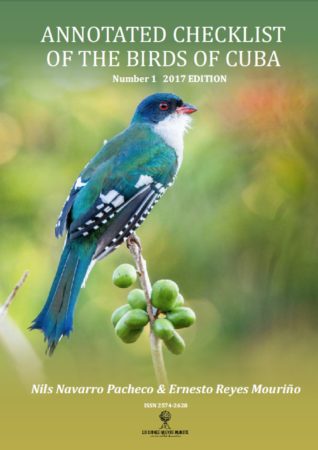 It is a pleasure to announce the publication of the first issue of the Annotated Checklist of the Birds of Cuba by Nils Navarro Pacheco and Ernesto Reyes Mouriño (No 1, 2017). This publication will serve as an official list and platform for work in the field of ornithology within the Cuban archipelago, as well as keeping the ornithological community updated on changes in taxonomy, systematics and new additions to the bird list of Cuba.
It is a pleasure to announce the publication of the first issue of the Annotated Checklist of the Birds of Cuba by Nils Navarro Pacheco and Ernesto Reyes Mouriño (No 1, 2017). This publication will serve as an official list and platform for work in the field of ornithology within the Cuban archipelago, as well as keeping the ornithological community updated on changes in taxonomy, systematics and new additions to the bird list of Cuba.
Earlier lists or volumes describing the birdlife of Cuba (Garrido and Montana, Catalogo de las Aves de Cuba 1975; Garrido and Kirkconnell, Field Guide to the Birds of Cuba, 2000; and Endemic Birds of Cuba, Navarro 2015) provide ample details on species behavior, habitat and range. This new checklist condenses and provides updated and new information on conservation status, endemism, abundance, breeding, and seasonality for 398 naturally occurring species and 15 exotics.
The checklist is beautifully illustrated with color photographs of Cuba’s 28 endemics on the back cover. The authors intend to update the list on an annual basis as verifiable information becomes available. With increased numbers of homegrown birders and professional ornithologists as well as foreign contributions, a “living” checklist under the careful stewardship of Navarro and Reyes makes perfect sense.
Cuba is the largest island in the West Indies and boasts 28 endemics as well as some of the most important habitats found in the region. Cubans, with support from abroad, have responded to the need to protect these habitats especially for endemic birds by developing many national parks and reserves, conducting ornithogical research, delivering outreach and education programs, and monitoring birds, for example, through the Caribbean Waterbird Census. While these efforts may have limited resources, the Cuban people and the conservationists they support are very proud of their birds and significant achievements. That passion bares fruit in this checklist when you look through the references and supporting documentation.
As one who is particularly interested in the ever-evolving state of West Indian avian biogeography, I appreciate the inclusion of a short communications section with articles on recent sightings and banding records and photographs of documented (with citations) recent rarities. I have no doubt that at least two factors—climate change and the increase in knowledgeable observers—are contributing to requisite checklist updates which the authors also recognize. The authors in fact encourage reporting of bird sightings through eBird Caribbean (Cornell Lab of Ornithological Database). Reports are vetted by local experts and contribute greatly to our knowledge of the status and trends of migratory and resident trends and status of species in Cuba as well as the West Indies. Many of you already understand that neotropical migrants, for example, spend only a few months (May-August) raising young on the North American continent before returning to the tropics. As you may have sensed, checklists of birds anywhere are outdated by the time they go to press.
So, in the tradition of James Bond’s Supplements to the Checklist of the Birds of the West Indies (1956-et seq.), this checklist is expected to provide intermittent updates founded by substantiating evidence and hopefully commentary by two of the leading field biologists in Cuba. I have worked with both Nils and Ernesto on reviving Christmas Bird Counts in Cuba since 2012 and can attest to their depth of knowledge and commitment to preserving the natural patrimony of Cuba. This and subsequent updates to the checklist should be a part of any West Indian ornithological library, both private and public, as a resource to measure changes in status of both resident and migratory Cuban birdlife in this hemisphere.
The checklist, published by Ediciones Nuevos Mundos, is a 40 page booklet, 8.0 x 11.5 inches in size, illustrated, with saddle stitch binding. The first print run is in English. The checklist can be purchased from the publisher for $12.00 (plus $3 shipping) at this link. A downloadable version is available here.
Robert Norton is a founding member of BirdsCaribbean (then the Society of Caribbean Ornithology); initiating author of the West Indies Region report (1980- ) North American Birds, American Birding Association; West Indies regional editor Christmas Bird Counts, National Audubon Society; eBird reviewer, Virgin Islands, Cornell Lab of Ornithology; coauthor w/ Patricia Bradley, Inventory of Breeding Seabirds of the Caribbean, 2009.
